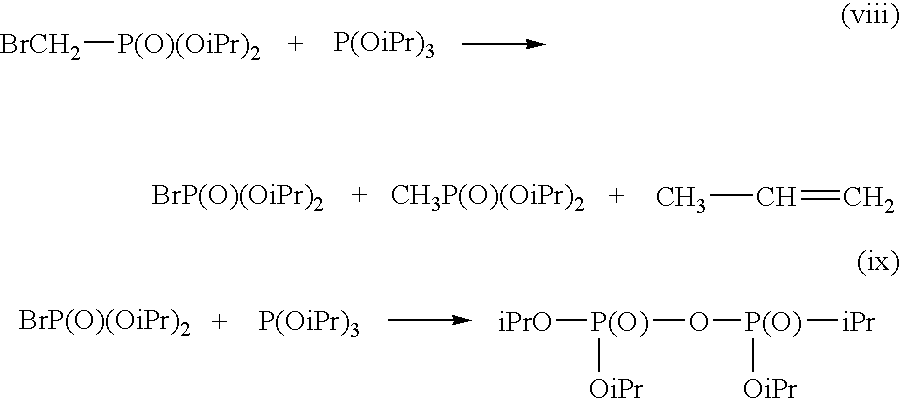Preparation of halohydrocarbyl phosphonic acid diesters
- Summary
- Abstract
- Description
- Claims
- Application Information
AI Technical Summary
Benefits of technology
Problems solved by technology
Method used
Image
Examples
example i
Comparative Example IA
[0065] To synthesize diisopropyl bromomethylphosphonate (DIPBMP), a two-necked 500 mL round bottom flask, was equipped with a 2 section Snyder distilling column and a distilling head. A 1.42 moles of dibromomethane (DBM) (248 g) and then 0.36 moles of triisopropyl phosphite (75 g) was added (TiPP) to the flask and the resulting mixture was degassed by bubbling nitrogen into the solution for 10 minutes. The mixture was then heated to a set point T of 110° C. The mixture was allowed to react for 25 hours over a four day period with the T of the mass between 105-109° C.
[0066] The completed reaction mixture had the composition identified in Table I below based on gas chromatographic (GC) area integration. The mixture contained 49.5% of the diisopropyl bromomethylphosphonate and 17.3% impurities which could not be removed effectively. After a repeated careful distillation via wiped film evaporation technique, DIPBMP with 86% purity was isolated with only 20% overa...
example ib
[0067] A reaction was carried out using the same molar ratio of TiPP to DBM as in Example IA; however, 1.92 moles of a polarity lowering additive, namely xylene was initially added to the flask together with the DBM reactant and the phosphite.
[0068] A Buchi 150 psi / 1.5 L autoclave reactor was flushed with nitrogen and the jacket temperature was set to 50° C. In a 1 L Erlenmeyer flask, triisopropyl phosphite (260 g, 1.25 moles), dibromomethane (869 g, 5.0 moles), and xylene (isomers plus ethylbenzene, 204 g, 1.92 moles) were combined giving a total volume of 900 mL. Using a liquid pump, the autoclave was charged with the reaction mixture. The system was pressurized with nitrogen to 20 psig and then depressurized. This procedure was repeated three more times.
[0069] The autoclave was sealed and heated to a set reaction T of 125° C. with stirring at 400 rpm. The reaction was continued at 125° C. for 24 hours with the pressure steadily increasing to 24 psig. After 24 hours at 125° C., ...
example iii
[0072] A reaction was carried out as in Example IB under essentially the same reaction conditions with the same apparatus, and the same reactants and polarity lowering additive; however, the molar ratio of the reactant and additive components were as follows: TiPP to DBM to xylene: 1 / 5.7 / 2.2 respectively. The completed reaction mixture resulted in 69.5% DIPBMP product. The excess dibromomethane reactant and xylene were removed via distillation and the stripped reaction mixture was subsequently washed with 3 parts of xylene and 4 parts of 0.1 N NaOH. The aqueous layer was removed and the organic layer washed with 4 parts of water three times. The xylene was removed from the washed sample which afforded diisopropyl bromomethylphosphonate product with 87% purity in a yield of 50% based on the initial TiPP reactant.
PUM
 Login to View More
Login to View More Abstract
Description
Claims
Application Information
 Login to View More
Login to View More - R&D
- Intellectual Property
- Life Sciences
- Materials
- Tech Scout
- Unparalleled Data Quality
- Higher Quality Content
- 60% Fewer Hallucinations
Browse by: Latest US Patents, China's latest patents, Technical Efficacy Thesaurus, Application Domain, Technology Topic, Popular Technical Reports.
© 2025 PatSnap. All rights reserved.Legal|Privacy policy|Modern Slavery Act Transparency Statement|Sitemap|About US| Contact US: help@patsnap.com



